Study on the Characteristics of Coal Ultrasonic Response during Loading and Its Influence Mechanism
Abstract
1. Introduction
2. Materials and Methods
2.1. Ultrasonic Propagation Theory of Coal during Stress Loading
2.1.1. Theory of Ultrasonic Velocity Change
2.1.2. Ultrasonic Wave Propagation Energy Attenuation Theory
2.2. Experiment
2.2.1. Experimental Equipment
2.2.2. Measurement Principle
- (1)
- Measurement of wave velocity.
- (2)
- Measurement of quality factor.
2.2.3. Coal Sample Collection and Preparation
2.2.4. Experimental Scheme and Steps
- Clean the sticking position of the coal sample’s strain gauge, firmly stick the strain gauge on the coal sample surface with glue, and press it hard to ensure full contact. After the glue is dry and firmly connected, the resistance value is checked with a strain gauge to ensure no open circuit or short circuit.
- In order to improve the measurement accuracy, the coupling agent is applied to the coal sample and the ultrasonic transducer probe, and put the coal sample into the loading test system. Thus, the coal sample is consistent with the central axis of the transducer probe to ensure stable placement.
- Connect the outgoing line of the strain gauge with the strain measurement instrument, and obtain the strain of the coal through the output of the strain measurement instrument.
- Connect the ultrasonic testing instrument following the experimental setting, turn on the computer control terminal and digital oscilloscope power, and debug to assure the normal use of the instrument.
- Adjust the loading system for controlling axial pressure change, and load the coal sample by stages until it breaks. Stabilize the voltage for 5 min after each new stress value is loaded, read out the corresponding ultrasonic wave velocity, record the first wave amplitude, and export the waveform data on the oscilloscope.
- Record the loading stress value, axial strain, and ultrasonic response characteristic parameters, and repeat step 5 until the coal sample is broken and the experiment is completed.
3. Results
3.1. Experimental Results
3.2. Relationship between the Ultrasonic Velocity and Axial Strain of Coal Sample during Stress Loading
- As the loading step increases, the axial strain of the coal sample will be on a rise, while the LWV and TWV will present an increase-to-decrease trend.
- The wave velocity exhibits strong anisotropy. The coal sample possesses higher LWV than TWV, and the LWV in the Z direction is lower than that in the X and Y directions. Through numerical analysis, the Pearson correlation coefficient of the TWV in the X and Y directions is 0.96501, indicating that the TWV in the X and Y directions is similar. During the whole process of stress loading, the TWV in the X and Y directions of the coal sample showed a change trend of “increase-slow increase-slow decrease-sharply decrease”. The TWV in the X direction increases from 1056 m/s to 1296 m/s in the stress range of 0–1.5 MPa. Then, with the increase of axial stress to 6.6 MPa, the TWV in X direction increases slowly from 1296 m/s to 1408 m/s. Then, it slowly decreases to 1321 m/s, and the axial stress is 7.2 MPa. After the coal sample is damaged, the stress value drops sharply to 1.5 Mpa, and the TWV in the X direction decreases sharply to 893 m/s. The TWV in the Y direction increases from 959 m/s to 1364 m/s in the stress range of 0–1.5 Mpa. Then, with the increase of axial stress to 6.6 MPa, the TWV in Y direction increases slowly from 1364 m/s to 1416 m/s. Subsequently, it slowly begins to decrease to 1300 m/s, and the axial stress is 7.2 MPa. After the failure of the coal sample, the stress value drops sharply to 1.5 MPa, and the TWV in the Y direction decreases sharply to 864 m/s. The Pearson correlation coefficient of the LWV in the X and Y directions is 0.98241, indicating that the LWV in the X and Y directions is similar. In the whole process of stress loading, the LWV of coal samples in X and Y directions showed the change trend of “increase-slow increase-slow decrease-sharply decrease”. The LWV in the X direction increases from 1925 m/s to 2280 m/s in the stress range of 0–1.5 MPa; then, as the axial stress increases to 6.6 MPa, the LWV in the X direction slowly increases from 2280 m/s to 2434 m/s, and then slowly decreases to 2347 m/s, and the axial stress is 7.2 Mpa. After the coal sample is destroyed, the stress value drops sharply to 1.5 Mpa, and the LWV in the X direction decreases sharply to 1743 m/s. The LWV in the Y direction increases from 1886 m/s to 2342 m/s in the stress range of 0–1.5 Mpa. Then, with the increase of axial stress to 6.6 Mpa, the LWV in the Y direction increases slowly from 2342 m/s to 2412 m/s, and then decreases slowly to 2296 m/s, and the axial stress is 7.2 Mpa. After the coal sample is destroyed, the stress value drops sharply to 1.5 Mpa, and the LWV in the Y direction decreases sharply to 1695 m/s.
- According to the stress loading process of coal samples, the changes in axial strain, LWV, and TWV fall into the initial stage, the middle stage, the late stage, and end stage of stress loading.
- In the early stage of stress loading, the LWV, TWV, and axial strain of coal samples increase. In the middle stage of stress loading, the LWV, TWV, and axial strain of coal samples increase slowly. In the late stage of stress loading, the axial strain of coal samples showed a significant increase trend, and the LWV and TWV of coal samples began to decrease slowly. At the end of the stress loading, the coal sample is broken, the axial strain of the coal sample increases sharply, and the LWV and TWV of the coal sample decreases sharply. The reasons for these trends are as follows: in the early stage of stress loading, the coal structure is compressed, the size of pores and cracks in the coal decreases, the axial strain increases, and the acoustic wave velocity of the coal increases. In the middle of stress loading, with the increase of axial pressure, the compression amplitude of coal structure decreases, so the LWV, TWV, and axial strain of coal sample increase slowly. In the late stage of stress loading, the coal enters the plastic stage, the internal cracks of the coal sample begin to increase, the size of the pores and cracks increases, the axial strain of the coal sample increases, and the LWV and TWV of the coal sample begin to decrease slowly. At the end of the stress loading, because the load of the coal sample exceeds its maximum bearing capacity, a large number of cracks appear in the coal, the axial strain increases sharply, and the wave velocity decreases abruptly.
- In the initial and middle stages, the ultrasonic velocity and axial strain of coal samples present an uptrend and have a good positive correlation. In the late stage and at the end of stress loading, the axial strain continues to increase, while the wave velocity significantly decreases. The ultrasonic velocity of coal samples shows a negative correlation with the axial strain.
3.3. Relationship between the Axial Strain and Quality Factor of Coal Sample during Stress Loading
- The quality factors of coal samples also demonstrate strong anisotropy. The quality factors of coal samples in the Z direction are less than those in the X and Y directions. The quality factors of coal samples in the two directions are similar, and the variation law is the same. In other words, coal samples present a higher wave velocity attenuation amplitude in the Z direction relative to the X and Y directions.
- The variation trend of coal sample quality factors during stress loading also falls into the initial stage, the middle stage, the late stage, and the end stage of stress loading. In the initial stage, the coal sample quality factor significantly increases. In the middle stage, the quality factor slowly increases. In the late stage, the quality factor significantly decreases. At the end of stress loading, the quality factor sharply decreases.
- In the initial and middle stage of stress loading, the coal sample quality factor increases as the axial strain increases, indicating that the attenuation amplitude of energy during ultrasonic propagation decreases as the axial strain increases. In the late stage and at the end of stress loading, the axial strain of coal samples keeps increasing, while the quality factor of coal samples sharply decreases, implying that the attenuation range of energy during ultrasonic propagation increases as the axial strain increases.
3.4. Relationship between Coal Sample Wave Velocity and Quality Factor during Stress Loading
4. Discussion
4.1. Analysis of Influencing Factors of Coal Ultrasonic Velocity Change during Stress Loading
4.2. Analysis of Influencing Factors of Ultrasonic Propagation Energy Attenuation
4.3. Relationship between the Stress–Strain State of the Coal and Ultrasonic Response Characteristics during Stress Loading
5. Conclusions
- (1)
- The coal stress-loading process falls into the elastic deformation stage and the plastic deformation stage. In the process of stress loading, the ultrasonic velocity and the quality factor of the coal sample have the same variation law. In the elastic deformation stage, the ultrasonic velocity and quality factor of the coal sample increase as coal axial strain elevates; in the plastic deformation stage, coal samples’ axial strain continues to increase, while the ultrasonic velocity and quality factor significantly decline.
- (2)
- In the process of stress loading, the ultrasonic velocity and quality factor of the coal sample demonstrate strong anisotropy, and are smaller in the Z direction than those in the X and Y directions. The ultrasonic velocity and quality factor of the coal sample in the X and Y directions are similar and present the same variation law.
- (3)
- Coal porosity is the fundamental factor influencing the change in the coal wave velocity and coal quality factor. In the elastic deformation stage, the coal stress increases, and the porosity decreases; the coal wave velocity and coal quality factor both increase, and the coal attenuation coefficient decreases. It is revealed that the primary factor that impacts the coal wave velocity and coal quality factor is stress. In the stage of plastic deformation, the porosity increases as the coal strain is on a rise, the coal wave velocity and coal quality factor decreases, and the coal attenuation coefficient increases, suggesting that the main factor affecting coal wave velocity and coal quality factor was strain.
- (4)
- The wave velocity and coal quality factor rapidly increase in the pore compaction stage and slowly increase in the linear deformation stage. The wave velocity and coal quality factor slowly decrease in the stage of microcrack propagation, while the wave velocity and coal quality factor rapidly decrease in the stage of coal destruction. The stress–strain state of coal corresponds well to the ultrasonic response characteristics during the loading process.
Author Contributions
Funding
Institutional Review Board Statement
Informed Consent Statement
Data Availability Statement
Acknowledgments
Conflicts of Interest
References
- Cheng, L.; Wang, Y.; Zhao, H. Research status and prospect of acoustic characteristics of coal and rock. Adv. Geophys. 2013, 28, 452–461. [Google Scholar] [CrossRef]
- Karimaei, M.; Dabbaghi, F.; Dehestani, M.; Rashidi, M. Estimating Compressive Strength of Concrete Containing Untreated Coal Waste Aggregates Using Ultrasonic Pulse Velocity. Materials 2021, 14, 647. [Google Scholar] [CrossRef] [PubMed]
- Wang, B.; Hao, J.; Liu, S.; Zhou, F.; Zhang, Z.; Zhang, H.; Sun, H. Experimental Study on the Effect of Gas Pressure on Ultrasonic Velocity and Anisotropy of Anthracite. Geofluids 2019, 2019, 3183816. [Google Scholar] [CrossRef]
- Kim, W.; Jeong, K.; Lee, T.; Park, S. A Study on Correlation between Ultrasonic Pulse Velocity Method and Coarse Aggregate for Estimating Residual Modulus of Elasticity of Concrete Exposed to High Temperatures. Appl. Sci. 2022, 12, 6644. [Google Scholar] [CrossRef]
- Krzesinska, M. Averaged Structural Units in Bituminous Coals Studied by Means of Ultrasonic Wave Velocity Measurements. Energy Fuels 2001, 15, 930–935. [Google Scholar] [CrossRef]
- Kong, X.; He, D.; Liu, X.; Wang, E.; Li, S.; Liu, T.; Ji, P.; Deng, D.; Yang, S. Strain characteristics and energy dissipation laws of gas-bearing coal during impact fracture process. Energy 2022, 242, 123028. [Google Scholar] [CrossRef]
- Solís-Carca1o, R.; Moreno, E. Evaluation of concrete made with crushed limestone aggregate based on ultrasonic pulse velocity. Constr. Build. Mater. 2008, 22, 1225–1231. [Google Scholar] [CrossRef]
- Zhao, M. Research status and prospect of rock acoustic characteristics. J. Chongqing Jiaotong Univ. 2000, 19, 81–83. [Google Scholar] [CrossRef]
- Shea, V.; Hanson, D.; Dai, S. Determination of different stages of loading and failure of coal samples by elastic wave velocity and attenuation. Adv. Geophys. 1990, 5, 94–102. [Google Scholar]
- Meng, Z.; Zhang, J. Joachim Tiedemann: Relationship between rock physical and mechanical parameters of coal measures and acoustic velocity. J. Geophys. 2006, 49, 1505–1510. [Google Scholar] [CrossRef]
- Zhai, X. Study on Ultrasonic Characteristics of Rock under Uniaxial Loading; Chengdu University of Technology: Chengdu, China, 2008. [Google Scholar]
- Zhao, M.; Wu, D. Ultrasonic classification and strength prediction of engineering rock mass. J. Rock Mech. Eng. 2000, 19, 89–92. [Google Scholar]
- Guo, D.; Han, D.; Feng, Z. Experimental study on wave velocity characteristics of tectonic coal under confining pressure. Coal Sci. Technol. 1998, 4, 22–24. [Google Scholar] [CrossRef]
- Zhou, F. Experiment on the influence of cracks on the ultrasonic velocity of coal and rock-taking -Carboniferous coal seam in Qinshui Basin as an example. Coalf. Geol. Explor. 2012, 40, 71–74. [Google Scholar] [CrossRef]
- Tong, J.; Yang, D.; Li, Z.; Ren, H.; Wang, Z. Experimental analysis of coal seam wave velocity under different confining pressures. Coal Mine Saf. 2017, 48, 49–52. [Google Scholar] [CrossRef]
- Yan, L. Study on the wave velocity characteristics of coal and rock in Yangzhuang Coal Mine and its relationship with strength. Coal Sci. Technol. 2006, 34, 57–60. [Google Scholar] [CrossRef]
- Wu, J.; Jiang, Z.; Fan, C.; Lin, F. Study on wave velocity measurement of coal seam tensile strength. J. Geotech. Eng. 2005, 27, 999–1003. [Google Scholar] [CrossRef]
- Li, Q.; He, J.; Chen, J. Simultaneous ultrasonic experiment of dynamic and static elastic parameters of coal under formation pressure conditions in Qinshui Basin. Chin. J. Geophys. 2017, 60, 2897–2903. [Google Scholar] [CrossRef]
- Adam, L.; Van Wijk, K.; Otheim, T.; Batzle, M. Changes in elastic wave velocity and rock microstructure due to basalt-CO2-water reactions. J. Geophys. Res. Solid Earth 2013, 118, 4039–4047. [Google Scholar] [CrossRef]
- Engelder, T.; Plumb, R. Changes in situ ultrasonic properties of rock on strain relaxation. Int. J. Rock Mech. Min. Sci. 1984, 21, 75–82. [Google Scholar] [CrossRef]
- Nur, A. Effects of access on velocity anisotropy in rocks with cracks. Rock Mech. Eng. Geol. 1971, 76, 2002–2034. [Google Scholar] [CrossRef]
- Zheng, G.; Zhao, X.; Liu, J.; Li, Y. Experimental study on change in acoustic wave velocity when rock is loading. J. Northeast. Univ. 2009, 30, 1197–1200. [Google Scholar] [CrossRef]
- Liu, X.; Wang, X.; Wang, E.; Liu, Z.; Xu, X. Study on ultrasonic response to mechanical structure of coal under loading and unloading condition. Shock Vib. 2017, 2017, 7643451. [Google Scholar] [CrossRef]
- Chen, Z. Stress Strain Ultrasonic Response Characteristics of Coal during Loading; Henan Polytechnic University: Jiaozuo, China, 2018. [Google Scholar]
- Close, J. Natural fracture in coal. In Hydrocarbons from Coal; Law, B.E., Rice, D.D., Eds.; AAPG: Tulsa, OK, USA, 1993; Volume 38, pp. 119–132. [Google Scholar]
- Walker, L. Desities, porposites and surface area of coal macerals as measured by their interaction with gases, vapours and liquids. Fuel 1988, 67, 1615–1623. [Google Scholar] [CrossRef]
- Wang, Y. Basic Research on the Deformation and Rupture Microwave Radiation Law of Loaded Coal Body and Its Mechanism. Ph.D. Thesis, China University of Mining and Technology, Beijing, China, 2008. [Google Scholar]
- Wang, X.; Asem, P.; Chen, H.; Labuz, J. Microcracking in tensile fracture of a brittle rock. Eng. Fract. Mech. 2021, 251, 1–16. [Google Scholar] [CrossRef]
- Li, X.; Nie, B.; Yang, C.; Mao, Y. Experimental study on the variation law of sound wave velocity during coal loading. Coal Mine Saf. 2016, 47, 3–16. [Google Scholar] [CrossRef]
- Lu, P.; Shen, Z.; Zhu, G.; Fang, E. Permeability characterization and experimental study in the whole process of stress and strain of rock samples. J. Univ. Sci. Technol. China 2002, 32, 678–684. [Google Scholar] [CrossRef]
- Tao, Y.; Xu, J.; Cheng, M.; Li, S.; Peng, S. Theoretical analysis and experimental study on permeability of coal containing gas. J. Rock Mech. Eng. 2009, 28, 3363–3370. [Google Scholar] [CrossRef]
- Yang, T.; Tang, C.; Zhu, W.; Feng, Q. Coupling analysis of seepage and stress in rock fracture process. J. Geotech. Eng. 2001, 23, 489–493. [Google Scholar] [CrossRef]
- Yang, T.; Xu, T.; Liu, J.; Tang, S.; Yu, Q.; Shi, B. Stress-damage-seepage coupling model and its application in deep coal seam gas pressure relief practice. Chin. J. Rock Mech. Eng. 2005, 24, 2900–2905. [Google Scholar]
- Kong, X.; Wang, E.; Li, S.; Lin, H.; Xiao, P.; Zhang, K. Fractals and Chaos Characteristics of Acoustic Emission Energy about Gas-Bearing Coal During Loaded Failure. Fractals 2019, 27, 5. [Google Scholar] [CrossRef]
- Liu, C.; Jing, H.; Fang, L.; Xu, M. Theoretical study on acoustic attenuation model of gas pipeline leakage. Vib. Shock 2018, 37, 109–114. [Google Scholar] [CrossRef]
- Urick, R. The absorption of sound in suspensions of irregular particles. J. Acoust. Soc. Am. 1948, 20, 283. [Google Scholar] [CrossRef]
- O’Connell, R.J.; Budiansky, R. Seismic velocities in dry and saturated cracked solids. J. Geophys. Res. 1974, 79, 5412–5425. [Google Scholar]
- He, Y.; Ma, X. Modern Physics Experiment; Tsinghua University Publishing House: Beijing, China, 2003; pp. 198–206. [Google Scholar]
- Wu, X. Study on Acoustic Velocity and Its Related Properties in Petroleum Fluid; Institute of Geophysics, Chinese Academy of Sciences: Beijing, China, 2000. [Google Scholar]
- RaiC, S.; Hanson, K. Transverse-wave velocity anisotropy in sedimentary rock: A laboratory study. Geophysics 1988, 53, 800–806. [Google Scholar] [CrossRef]
- GB/T19222-2003; Coal and Rock Sampling Methods. China Standards Publishing House: Beijing, China, 2003.
- GB/T30050-2013; Coal Structure Classification. China Standards Publishing House: Beijing, China, 2013.
- Yale, D. Recent advances in rock physics. Geophysics 1985, 50, 2480–2491. [Google Scholar] [CrossRef]
- Meng, Z.; Liu, C.; He, X. Experimental analysis on acoustic velocity of coal measures rocks and its influencing factors. J. Min. Saf. Eng. 2008, 25, 390–394. [Google Scholar] [CrossRef]
- Li, Q.; He, J.; Li, C. Study on the relationship between compressional and shear wave velocities and formation pressure of coalbed methane reservoirs in Qinshui Basin. Geophys. Geochem. Calc. Technol. 2013, 35, 382–385. [Google Scholar] [CrossRef]
- Dong, S.; Wu, H.; Li, D.; Huang, Y. Experimental study of ultrasonic velocity and anisotropy in coal samples. J. Seism. Explor. 2016, 25, 131–146. [Google Scholar]
- Sun, X.; Chen, G.; Li, J.; Xu, X.; Fu, S.; Xie, J.; Liang, L. Propagation characteristics of ultrasonic P-wave velocity in artificial jointed coal briquettes. J. Geophys. Eng. 2020, 5, 827–837. [Google Scholar] [CrossRef]
- Zhang, L.; Zhang, Z.; Zhang, R.; Gao, M.; Xie, J. The Ultrasonic P-Wave Velocity-Stress Relationship and Energy Evolution of Sandstone under Uniaxial Loading-Unloading Conditions. Hindawi Ltd. 2021, 2021, 9921716. [Google Scholar] [CrossRef]
- Yu, H.; Zhang, Y.; Lebedev, M.; Wang, Z.; Li, X.; Squelch, A.; Verrall, M.; Lalauer, S. X-ray micro-computed tomography and ultrasonic velocity analysis of fractured shale as a function of effective stress. Mar. Pet. Geol. 2019, 110, 472–482. [Google Scholar] [CrossRef]
- Cao, A.; Dou, L.; Cai, W.; Gong, S.; Liu, S.; Jing, G. Case study of seismic hazard assessment in underground coal mining using passive tomography. Int. J. Rock Mech. Min. Sci. 2015, 78, 1–9. [Google Scholar] [CrossRef]
- Zhao, M. Study on Acoustic Characteristics of Fractured Rock Mass under Loading; Chongqing Jiaotong University: Chongqing, China, 1998. [Google Scholar]
- Yang, S.; Zhang, N.; Feng, X.; Kan, J.; Pan, D.; Qian, Q. Experimental Investigation of Sandstone under Cyclic Loading: Damage Assessment Using Ultrasonic Wave Velocities and Changes in Elastic Modulus. Shock Vib. 2018, 2018 Pt 3, 1–13. [Google Scholar] [CrossRef]
- Li, J.; Wang, H.; Zhang, Q. Progressive damage and fracture of biaxially-confined anisotropic coal under repeated impact loads. Int. J. Rock Mech. Min. Sci. 2022, 149, 4979. [Google Scholar] [CrossRef]
- Zhang, Z.; Wang, E.; Liu, X.; Zhang, Y.; Li, S.; Khan, M.; Gao, Y. Anisotropic characteristics of ultrasonic transmission velocities and stress inversion during uniaxial compression process. J. Appl. Geophys. 2021, 186, 104274. [Google Scholar] [CrossRef]
- Zhao, Q. Test and Research on Seismic Wave Parameters of Coal Seams; Anhui University of Science and Technology: Huainan, China, 2005. [Google Scholar]
- Zhang, P.; Liu, S.; Zhao, Q.; Guo, L. Analysis of attenuation characteristics and quality factors of coal seams in Huainan Mining Area. Coal Sci. Technol. 2006, 5, 83–85. [Google Scholar] [CrossRef]
- Liang, Y. Experimental Study on Ultrasonic and Pore Change Characteristics of Loaded Coal Containing Water; Henan Polytechnic University: Jiaozuo, China, 2020. [Google Scholar]


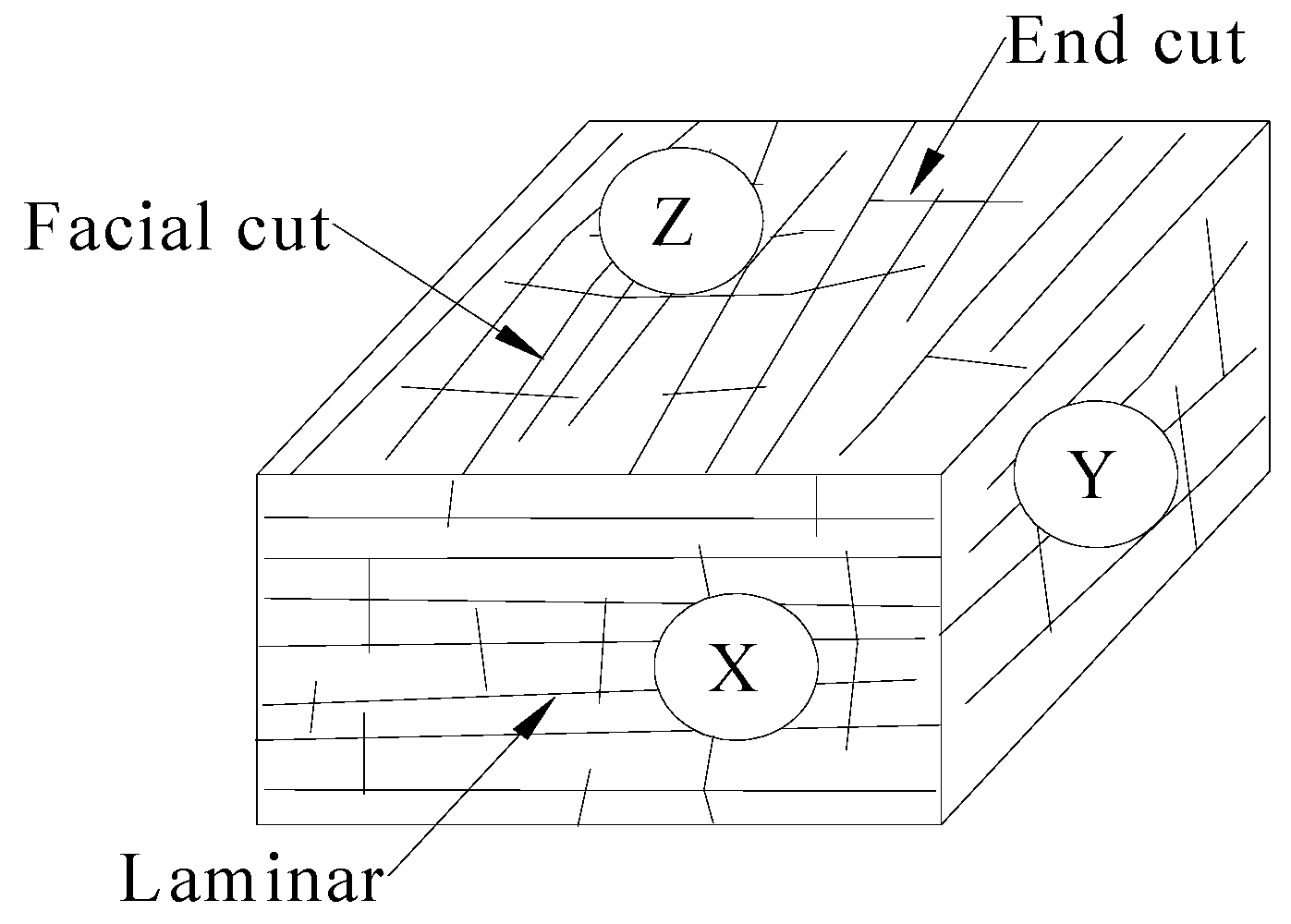

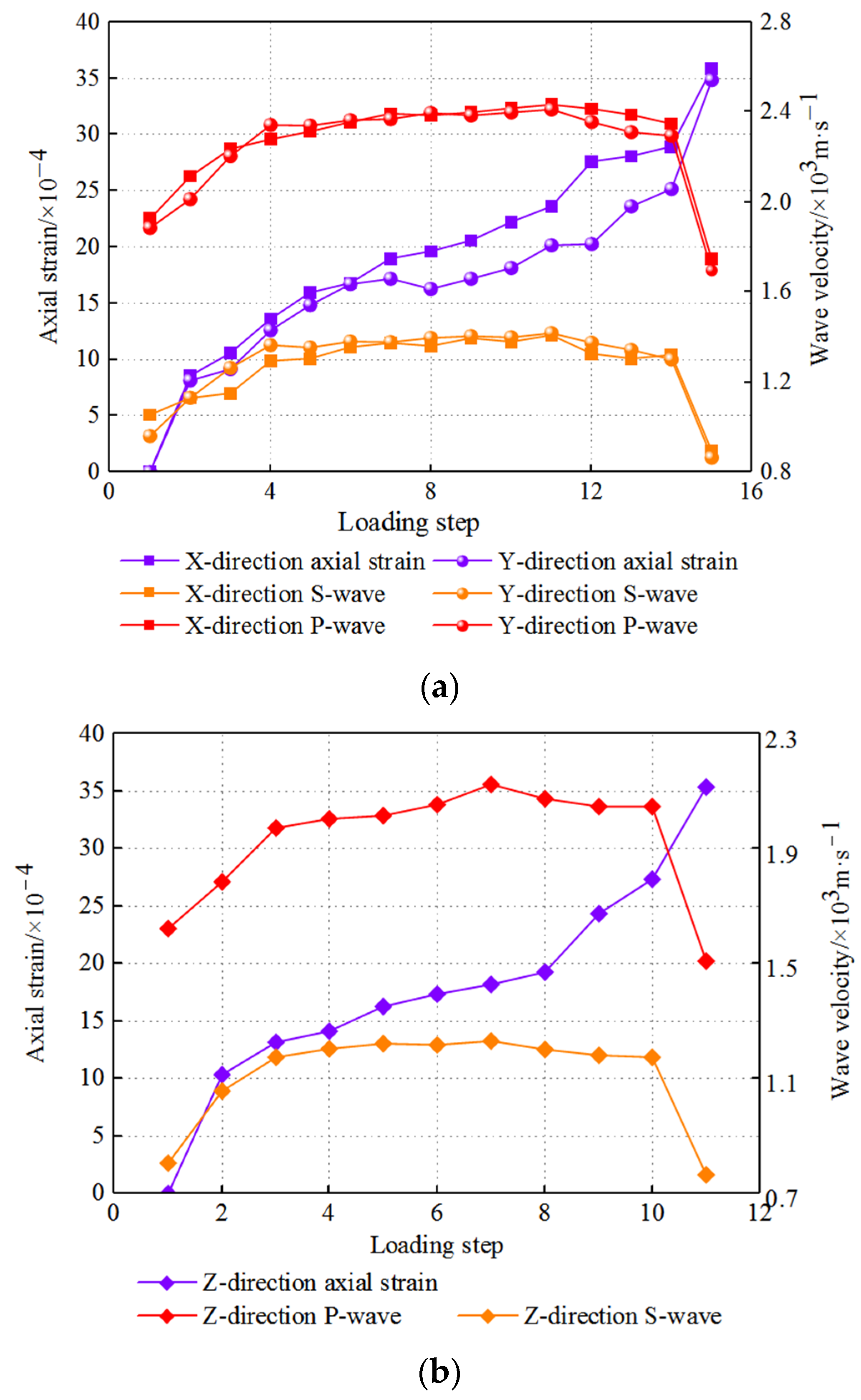
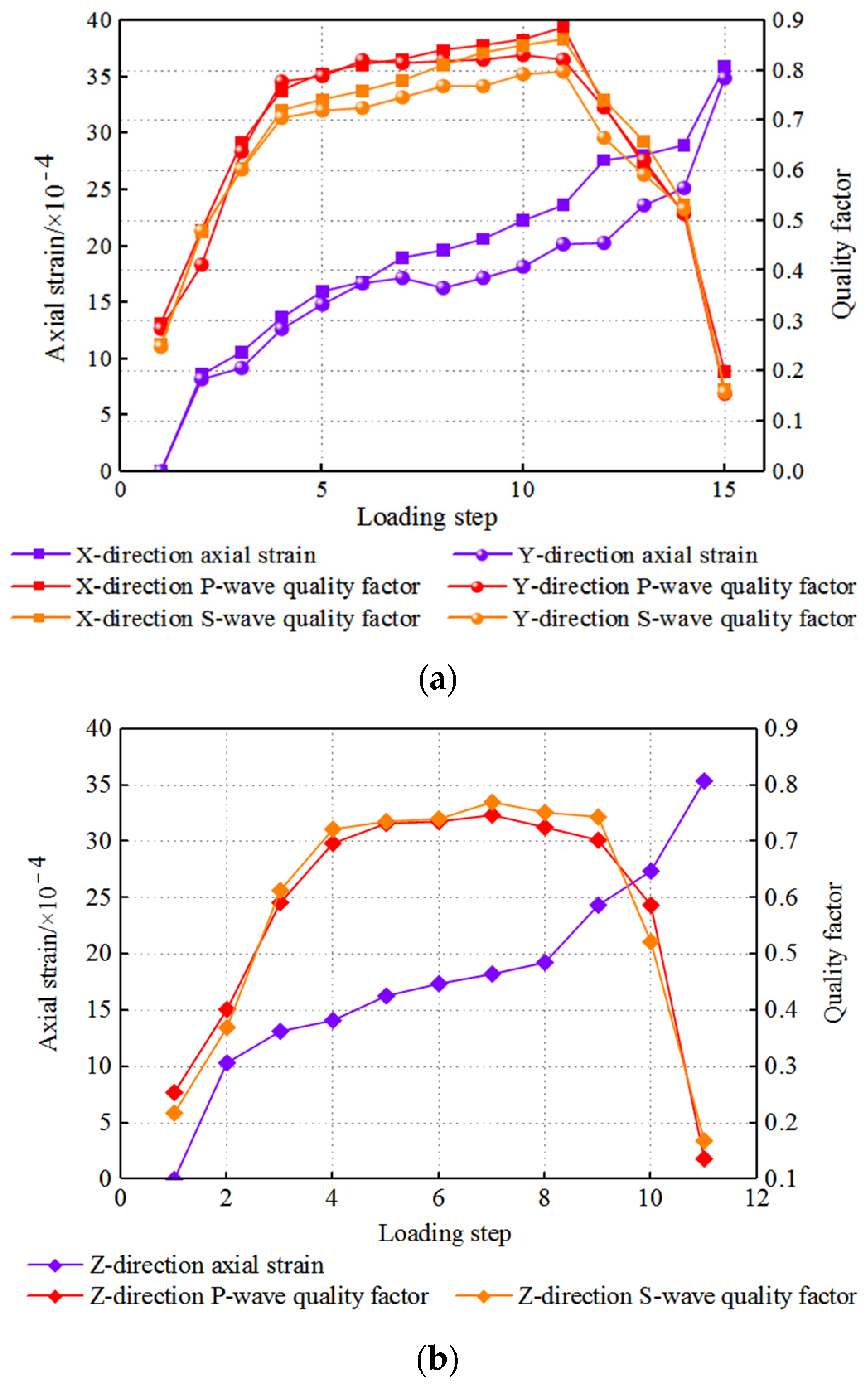
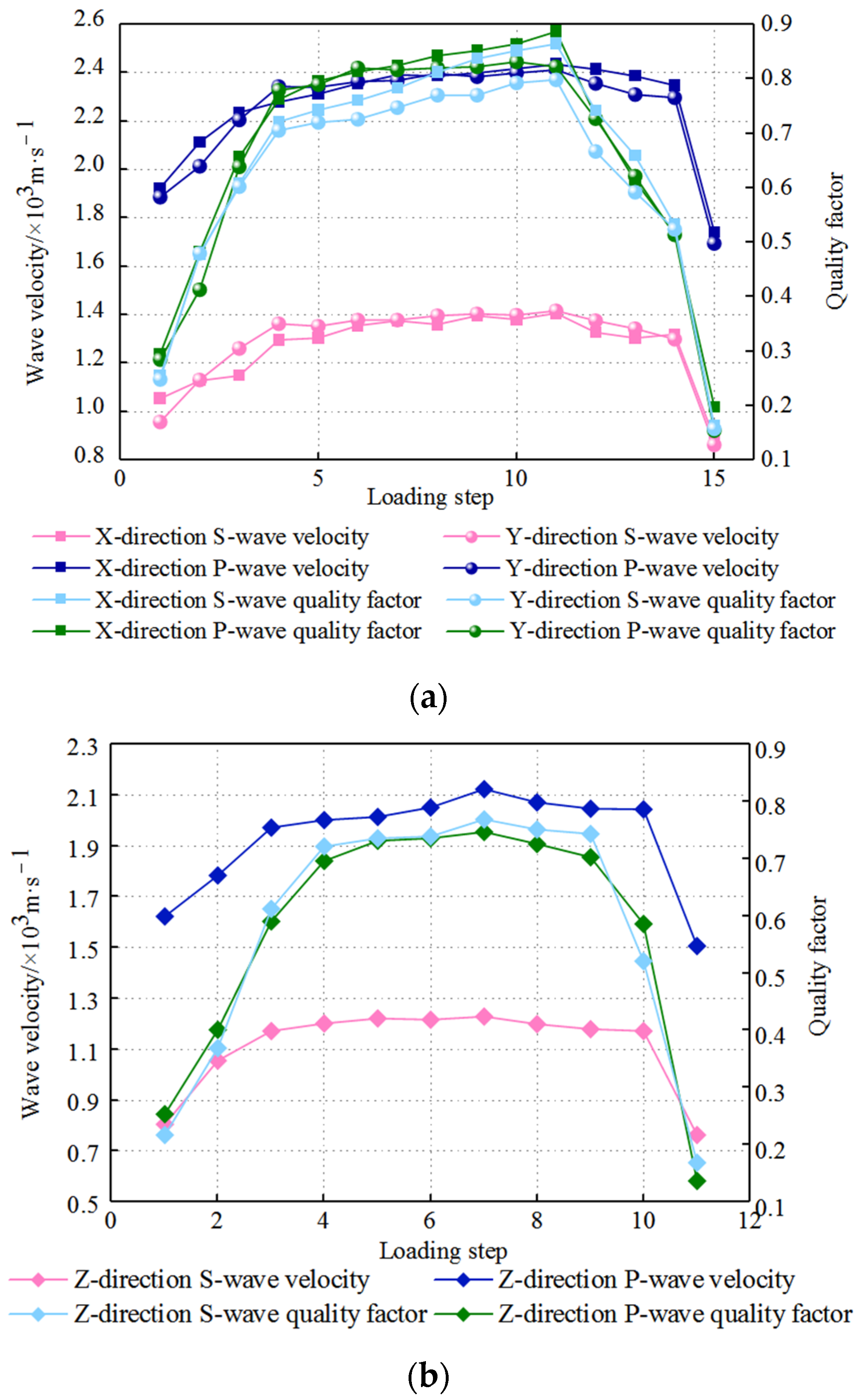




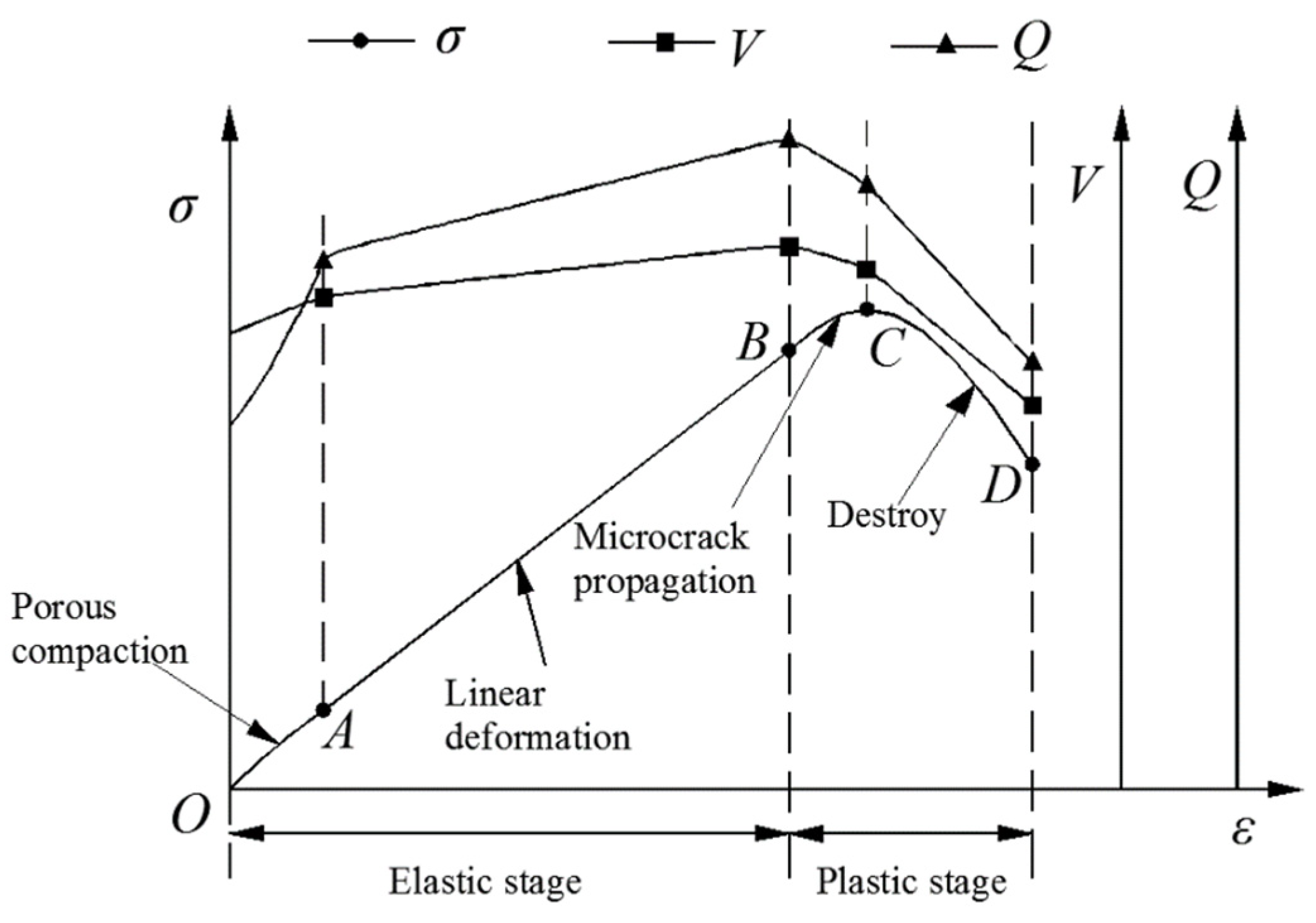
| Coal Sample Number | Coal Structure Type | Length (mm) | Diameter (mm) | Fracture Development | Ro,max | Vdaf (%) | Bulk Density (t/m3) | Porosity (%) | Modulus of Elasticity (MPa) | Poisson’s Ratio |
|---|---|---|---|---|---|---|---|---|---|---|
| IX1 | Primary structural coal | 100.0 | 50.1 | The bedding is clear without obvious cracks. | 1.86 | 15.7 | 1.43 | 3.5 | 1500 | 0.3 |
| IY1 | 99.9 | 49.9 | ||||||||
| IZ1 | 100.1 | 50.1 |
| Loading Step | Axial Stress (MPa) | P-Wave Velocity (m·s−1) | S-Wave Velocity (m·s−1) | Axial Strain (10−4) | Quality Factor Qp | Quality Factor Qs | |||||||||||
|---|---|---|---|---|---|---|---|---|---|---|---|---|---|---|---|---|---|
| X, Y | Z | X | Y | Z | X | Y | Z | X | Y | Z | X | Y | Z | X | Y | Z | |
| 1 | 0 | 0 | 1925 | 1886 | 1623 | 1056 | 959 | 807 | 0 | 0 | 0 | 0.2954 | 0.2846 | 0.2541 | 0.2541 | 0.2489 | 0.2182 |
| 2 | 0.4 | 0.5 | 2114 | 2013 | 1785 | 1129 | 1131 | 1056 | 8.5621 | 8.1562 | 10.3216 | 0.4823 | 0.4124 | 0.4015 | 0.4765 | 0.4795 | 0.3695 |
| 3 | 0.9 | 1 | 2236 | 2205 | 1973 | 1150 | 1262 | 1174 | 10.5689 | 9.1564 | 13.1684 | 0.6569 | 0.6386 | 0.5912 | 0.6071 | 0.6025 | 0.6128 |
| 4 | 1.5 | 1.5 | 2280 | 2342 | 2003 | 1296 | 1364 | 1203 | 13.6415 | 12.6156 | 14.1235 | 0.7614 | 0.7783 | 0.6962 | 0.7215 | 0.7054 | 0.7218 |
| 5 | 2.2 | 2.1 | 2312 | 2341 | 2016 | 1304 | 1352 | 1222 | 15.9501 | 14.8204 | 16.2605 | 0.7962 | 0.7893 | 0.7316 | 0.7428 | 0.7199 | 0.7356 |
| 6 | 2.9 | 2.8 | 2356 | 2364 | 2053 | 1356 | 1379 | 1218 | 16.7851 | 16.6925 | 17.3694 | 0.8124 | 0.8201 | 0.7356 | 0.7594 | 0.7259 | 0.7398 |
| 7 | 3.6 | 3.7 | 2392 | 2368 | 2123 | 1375 | 1378 | 1230 | 18.9654 | 17.1651 | 18.2068 | 0.8238 | 0.8158 | 0.7465 | 0.7816 | 0.7467 | 0.7695 |
| 8 | 4.2 | 4.1 | 2385 | 2395 | 2073 | 1362 | 1396 | 1201 | 19.6258 | 16.2609 | 19.2654 | 0.8417 | 0.8196 | 0.7256 | 0.8119 | 0.7692 | 0.7512 |
| 9 | 4.9 | 4.2 | 2399 | 2384 | 2048 | 1396 | 1403 | 1182 | 20.6041 | 17.1656 | 24.3654 | 0.8514 | 0.8214 | 0.7026 | 0.8364 | 0.7697 | 0.7435 |
| 10 | 5.8 | 4.3 | 2416 | 2399 | 2046 | 1381 | 1399 | 1174 | 22.2354 | 18.1561 | 27.3691 | 0.8632 | 0.8309 | 0.5865 | 0.8516 | 0.7927 | 0.5216 |
| 11 | 6.6 | 1.7 | 2434 | 2412 | 1508 | 1408 | 1416 | 765 | 23.6351 | 20.1656 | 35.3614 | 0.8863 | 0.8218 | 0.1369 | 0.8632 | 0.7983 | 0.1689 |
| 12 | 6.8 | — | 2415 | 2356 | — | 1327 | 1375 | — | 27.6248 | 20.2518 | — | 0.7312 | 0.7269 | — | 0.7415 | 0.6662 | — |
| 13 | 6.9 | — | 2387 | 2310 | — | 1305 | 1343 | — | 28.0695 | 23.6325 | — | 0.6124 | 0.6214 | — | 0.6589 | 0.5918 | — |
| 14 | 7.2 | — | 2347 | 2296 | — | 1321 | 1300 | — | 28.9562 | 25.1659 | — | 0.5164 | 0.514 | — | 0.5321 | 0.5238 | — |
| 15 | 1.5 | — | 1743 | 1695 | — | 893 | 864 | — | 35.8601 | 34.8661 | — | 0.1984 | 0.1541 | — | 0.1631 | 0.1578 | — |
Disclaimer/Publisher’s Note: The statements, opinions and data contained in all publications are solely those of the individual author(s) and contributor(s) and not of MDPI and/or the editor(s). MDPI and/or the editor(s) disclaim responsibility for any injury to people or property resulting from any ideas, methods, instructions or products referred to in the content. |
© 2023 by the authors. Licensee MDPI, Basel, Switzerland. This article is an open access article distributed under the terms and conditions of the Creative Commons Attribution (CC BY) license (https://creativecommons.org/licenses/by/4.0/).
Share and Cite
Xu, G.; Ma, T.; Wang, C.; Jin, H.; Wang, Y. Study on the Characteristics of Coal Ultrasonic Response during Loading and Its Influence Mechanism. Sustainability 2023, 15, 1093. https://doi.org/10.3390/su15021093
Xu G, Ma T, Wang C, Jin H, Wang Y. Study on the Characteristics of Coal Ultrasonic Response during Loading and Its Influence Mechanism. Sustainability. 2023; 15(2):1093. https://doi.org/10.3390/su15021093
Chicago/Turabian StyleXu, Gang, Tingting Ma, Chaofeng Wang, Hongwei Jin, and Yunlong Wang. 2023. "Study on the Characteristics of Coal Ultrasonic Response during Loading and Its Influence Mechanism" Sustainability 15, no. 2: 1093. https://doi.org/10.3390/su15021093
APA StyleXu, G., Ma, T., Wang, C., Jin, H., & Wang, Y. (2023). Study on the Characteristics of Coal Ultrasonic Response during Loading and Its Influence Mechanism. Sustainability, 15(2), 1093. https://doi.org/10.3390/su15021093










